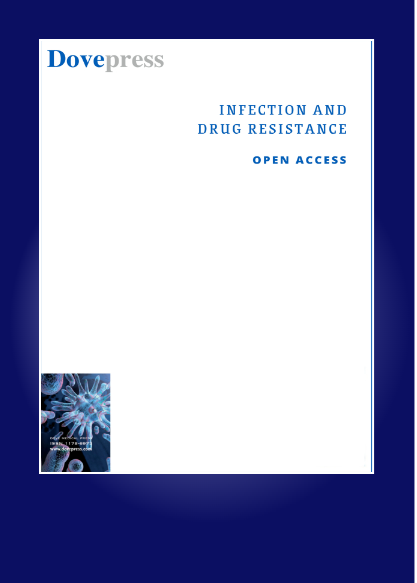利用新型机器学习系统预测约旦的广谱β-内酰胺酶细菌和多重耐药性
IF 2.9
3区 医学
Q2 INFECTIOUS DISEASES
引用次数: 0
摘要
背景:具有广谱β-内酰胺酶(ESBL)的微生物的发病率呈上升趋势,给公共卫生带来了重大隐患。目前机器学习(ML)的应用主要集中在预测细菌耐药性以优化抗生素治疗。本研究利用 ML 预测产生 ESBL 并对多种抗生素(MDR)表现出耐药性的细菌的发生率:六种流行的 ML 算法最初是在约旦 Al-Hussein/Salt 医院收集的抗生素耐药性测试患者报告(n = 489)上进行训练的。训练结果模型根据微生物学和患者临床数据预测 ESBL 和多重耐药性概况。结果用于选择最佳 ML 方法,以预测 ESBL 最相关的特征:结果:大肠埃希氏菌(E. coli,82%)是最常见的产生 ESBL 的微生物,具有多重耐药性。尿路感染(UTI)是最常见的临床诊断(68.7%)。分类与回归树(CART)和随机森林(RF)分类器是最有效的算法。与ESBL出现相关的特征包括年龄和不同类别的抗生素,包括头孢呋辛、头孢唑肟、头孢吡肟、三甲双胍/磺胺甲噁唑、环丙沙星和庆大霉素。硝基呋喃妥因、哌拉西林/他唑巴坦、阿米卡星、美罗培南和亚胺培南与 ESBL 类有明显的反比关系:结论:基于CART和RF的ML算法可用于预测ESBL最重要的特征。结论:CART和基于RF的ML算法可用于预测ESBL最重要的特征,强调了监测ESBL感染趋势的重要性,以促进适当的抗生素治疗。本文章由计算机程序翻译,如有差异,请以英文原文为准。
Extended Spectrum beta-Lactamase Bacteria and Multidrug Resistance in Jordan are Predicted Using a New Machine-Learning system
Background: The incidence of microorganisms with extended-spectrum beta-lactamase (ESBL) is on the rise, posing a significant public health concern. The current application of machine learning (ML) focuses on predicting bacterial resistance to optimize antibiotic therapy. This study employs ML to forecast the occurrence of bacteria that generate ESBL and demonstrate resistance to multiple antibiotics (MDR).
Methods: Six popular ML algorithms were initially trained on antibiotic resistance test patient reports (n = 489) collected from Al-Hussein/Salt Hospital in Jordan. Trained outcome models predict ESBL and multidrug resistance profiles based on microbiological and patients’ clinical data. The results were utilized to select the optimal ML method to predict ESBL’s most associated features.
Results: Escherichia coli (E. coli, 82%) was the most commonly identified microbe generating ESBL, displaying multidrug resistance. Urinary tract infections (UTIs) constituted the most frequently observed clinical diagnosis (68.7%). Classification and Regression Trees (CART) and Random Forest (RF) classifiers emerged as the most effective algorithms. The relevant features associated with the emergence of ESBL include age and different classes of antibiotics, including cefuroxime, ceftazidime, cefepime, trimethoprim/ sulfamethoxazole, ciprofloxacin, and gentamicin. Fosfomycin nitrofurantoin, piperacillin/tazobactam, along with amikacin, meropenem, and imipenem, had a pronounced inverse relationship with the ESBL class.
Conclusion: CART and RF-based ML algorithms can be employed to predict the most important features of ESBL. The significance of monitoring trends in ESBL infections is emphasized to facilitate the administration of appropriate antibiotic therapy.
Methods: Six popular ML algorithms were initially trained on antibiotic resistance test patient reports (n = 489) collected from Al-Hussein/Salt Hospital in Jordan. Trained outcome models predict ESBL and multidrug resistance profiles based on microbiological and patients’ clinical data. The results were utilized to select the optimal ML method to predict ESBL’s most associated features.
Results: Escherichia coli (E. coli, 82%) was the most commonly identified microbe generating ESBL, displaying multidrug resistance. Urinary tract infections (UTIs) constituted the most frequently observed clinical diagnosis (68.7%). Classification and Regression Trees (CART) and Random Forest (RF) classifiers emerged as the most effective algorithms. The relevant features associated with the emergence of ESBL include age and different classes of antibiotics, including cefuroxime, ceftazidime, cefepime, trimethoprim/ sulfamethoxazole, ciprofloxacin, and gentamicin. Fosfomycin nitrofurantoin, piperacillin/tazobactam, along with amikacin, meropenem, and imipenem, had a pronounced inverse relationship with the ESBL class.
Conclusion: CART and RF-based ML algorithms can be employed to predict the most important features of ESBL. The significance of monitoring trends in ESBL infections is emphasized to facilitate the administration of appropriate antibiotic therapy.
求助全文
通过发布文献求助,成功后即可免费获取论文全文。
去求助
来源期刊

Infection and Drug Resistance
Medicine-Pharmacology (medical)
CiteScore
5.60
自引率
7.70%
发文量
826
审稿时长
16 weeks
期刊介绍:
About Journal
Editors
Peer Reviewers
Articles
Article Publishing Charges
Aims and Scope
Call For Papers
ISSN: 1178-6973
Editor-in-Chief: Professor Suresh Antony
An international, peer-reviewed, open access journal that focuses on the optimal treatment of infection (bacterial, fungal and viral) and the development and institution of preventative strategies to minimize the development and spread of resistance.
 求助内容:
求助内容: 应助结果提醒方式:
应助结果提醒方式:


